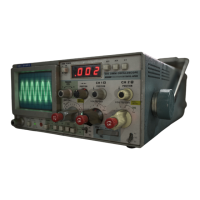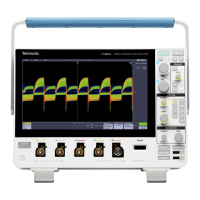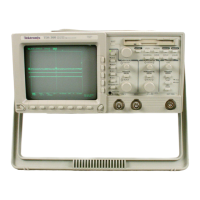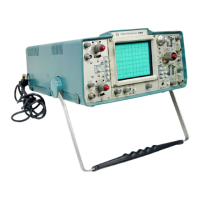Theory of Operation-31
4
Service
selector switch, S602. The Line-Voltage selector, S601, Regulator is short circuited to ground through R602. The
connects the split primaries of T6OO in parallel for 115-volt
large current drawn by R602 opens the line fuse.
operation and in series for 230-volt operation.
The Line Fuse, F600, should be of the proper value for
Auto Turn Off
each nominal line voltage to protectthe instrument. Fuses
are internally accessi ble. Procedures for fuse replacement
When the input level of the Series Regulator falls below
and cabinet removal may be found in the Maintenance
the specified levels (about +20.5 volts in the 115/230-volt
ac and the +24 V dc positions of Power Source selector
sectionofthismanual.Referfusereplacementtoqualified
switch
S605
or
about
volts
in
the
+12
dc
service personnel only. See Electrical Parts List for correct
position),
Q612
and
Q610
turn
on,
Q607,
through
Q609
fuse values.
and U615, turns off, preventing the operation of the dc-to-
Power Source Selector
dc converter.
The Power Source selector switch, S605, selects one of
three sources:
115/230-V ac,
+
12-V dc, or +24-V dc. The
regulating ranges (HI-LO-MED) of these voltages are
listed on the rear cover of the instrument.
Series Regulator
The Series Regulator circuit regulates the output of the
dc-to-dc Converter circuit.
U615, (2607, and Q609 and associated circuitry make
up the series regulator circuit. U615 includes a com-
parator amplifier and a reference voltage output. Q609
serves as a regulating device. R627, R628, and R629 form
the output voltage monitoring system.
The voltage from R628 (voltage-monitor output) is
applied to one input (pin 2) of U615. The other comparator
input (pin 3) receives a reference voltage from pin 4 of
U615 through R626. The monitoring voltage is compared
to the reference voltage, and any error voltage is amplified
in
U615. The amplified error voltage (at pin 7 of U615)
drives Q607 and Q609. This drive from pin 7 of U615
controls Q607 impedance, holding the dc-to-dc converter
output voltage constant.
R628, $12 V Adjust, sets the
converter output level.
DC-to-DC Converter
The converter multivibrator (Q657, Q660, Q658 and
T665) converts the dc supply voltage (from Q607) to ac.
This ac is applied to T600 primary. T600 secondary
voltages are rectified to provide dc operating voltages for
the instrument.
The voltage at
+12(A) provides the dc voltage to the
comparison divider R627, R628, and R629.
Regulator Protection
If the input voltage to the Series Regulator circuit rises
above about +40 volts, Q605 (SCR) turns on and is held in
the on state. When
Q605 conducts, the input to the Series
Low-Line Indicator
When the input level of the Series Regulator falls below
the specified levels (about +22 volts in the 115/230 V ac
and +24 V dc position of Power Source selector switch
S605, or about +11 volts in the +12 V dc position), Q635
turns on. The reference for Q635 and Q637 bases is pin 4of
U615. When Q635 turns on, astable multivibrator (2638-
Q640 runs at about two hertz, causing low-line indicator to
blink.
+6
V and
-6
V Regulators
@
The +12-volt supply and VR760 provide the reference
voltage for the +6-volt regulator. R762 adjusts the output
to 6 volts. U765 is the regulator and
Q767 the pass
transistor.
U765B is the regulator for the -6-volt supply, with the
+6-volt supply providing the reference voltage. Q772 is
the -6-volt pass transistor.
HV
AND UNBLANKING
@
General
This circuit provides the high voltage and control
circuitry for crt operation. Fig. 3-13 is a block diagram of
the circuit.
High Voltage and CRT
Multiples of T660 secondary voltage are obtained
between CR692A cathode and CR692F anode. CR692E
(cathode) is connected to one end of the voltage divider
network, R697 through
R707. The R707 end of the divider
connects to CR692F anode, providing operating voltage
for Q700. This divider network also provides voltages for
the Intensity and Focus controls and the crt writing-gun
cathode. Any change in the writing-gun cathode level is
fed back to a series regulator circuit
(Q710, Q712, and
(2717) through feedback resistor R712. This series
regulator circuit amplifies and inverts the error signal. The
3-20
REV.
B
FEB
1977

